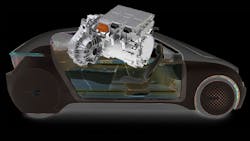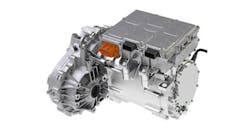Partnership Aims to Speed Delivery of Scalable, 3-in-1 eDrive Systems
Electric and hybrid vehicles must become more affordable for consumers and more profitable for producers. For that to happen, suppliers have to find new and better ways to make electric propulsion more economically viable.
Standardizing electric drive systems with integrated inverters and motors—combining the electric motor, gearbox, and power electronics into a single package—could reduce cost, weight, and packaging for car manufacturers. In turn, it will make electrification more affordable.
To that end, GKN Automotive and Delta Electronics of Taiwan, a global provider of switching power supplies and thermal-management products, announced their collaboration aimed at enabling more rapid acceleration of next-generation integrated 3-in-1 eDrive systems. An electric motor and inverter supplied by Delta Electronics is integrated with GKN Automotive’s eMotor and single-speed transmission module in a 3-in-1 solution. GKN’s Automotive SPICE Level 2- and 3-certifed software engineering processes enable it to manage the system’s complete integration.
According to the two companies, within three years, the new 3-in-1 eDrive units will be available for the start of production in a multitude of vehicle types, from A-segment city cars to D-segment executive cars and SUVs. The units will support a range of torque outputs from 2,000 to 5,800 Nm, with nominal power outputs of between 80 and 155 kW.
Using a quiet electric engine unmasks high-frequency noise caused by the transmission. GKN says reducing noise, vibration, and harshness (NVH) is possible with its new Powder Metallurgy (PM) gears tailored for EV or HEV modular drivetrain platforms. The compact eDrive setup with electric motor, gearbox, and inverter all in one housing also can be optimized to suppress noise and vibrations, delivering greater refinement and efficiency than powertrains incorporating separately packaged elements (for maximum serviceability, the inverter will retain its own separate housing in the 3-in-1 setup).
Hybrid Topology
GKN Automotive’s eDrive systems are said to be capable of providing either full-electric power, or hybrid-electric power, to support an existing internal combustion engine (ICE). The hybrid-electric topology can be characterized by the positioning of the main components of the hybrid-electric system on the vehicle:
- P0: The electric motor is connected to the ICE through a belt on the front-end accessory drive.
- P1: The electric motor is connected directly with the crankshaft of the internal combustion engine.
- P2: The electric motor is side-attached (through a belt) or integrated between the ICE and the transmission; it’s decoupled from the ICE and it has the same speed of the ICE (or a multiple of it).
- P3: The electric motor is connected through a gear mesh with the transmission; the electric machine is decoupled from the ICE and its speed is a multiple of the wheel speed.
- P4: The electric motor is connected through a gear mesh on the rear axle of the vehicle; it’s decoupled from the ICE and located in the rear axle drive or in the wheel hub.
P0 and P1 architectures don’t allow for the mechanical disconnection of the electric motor from the engine. On the other hand, P2, P3, or P4 configurations disconnect the electric motor from the engine through a clutch.
The high efficiency of P4 electric axle drive architectures will make them central to most pure electric and plug-in hybrid strategies going forward. In the P4 hybrid-electric drive systems, the electric motor is decoupled from the ICE—the inverter and motor are coupled into a compact transmission module that applies torque directly to the rear wheels and recovers energy directly from the wheels when braking.
To provide the best balance of cost and performance, single-speed systems are expected to account for 94% of P4 eDrive volumes. By 2026, annual production of P4 electric-drive systems is forecast to reach around 13 million units, according to GKN.
In a statement, GKN Automotive said it’s the world’s leading supplier of P4 electric drive systems. This next phase of its electrification strategy will produce the highly integrated, modular, scalable architectures required for high-volume vehicle applications. Standardizing these systems will make electrification more affordable and will enable OEMs to offer consumers optimized e-mobility “at the right price.”
Meeting Emission Rules
Regulation remains a main driver for electrification in Europe and the U.S., with CO2 penalties providing a strong financial incentive for automakers. Under EU rules, carmakers must lower average CO2 emissions from the vehicles across their fleet to 95g per km, or face penalties that could run into hundreds of millions, even billions, of euros. Industry forecasts indicate that by 2026, one in every 10 vehicles sold worldwide will be a battery electric vehicle.
Together, GKN and Delta will invest about £100 million a year (approximately $130 million) in developing standardized eDrive solutions for the next generation of battery-powered vehicles. They say their new solution will cover a large portion of the future eDrive market, which is projected by IHS to be worth more than £12 billion (approximately $15.6 billion) by 2030.

